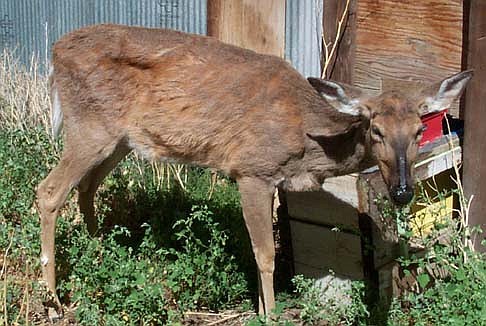The Missouri Department of Conservation doesn't know how a buck in Cole County contracted chronic wasting disease, and the department will not change any regulations until it learns more.
In the meantime, some state officials have resigned themselves to the fact chronic wasting disease has become a permanent part of the state's landscape.
"We need to learn, now, how to step back and live with it," said Sen. Brian Munzlinger, the Republican whip from Williamstown who has sponsored legislation to make it easier for deer farms to produce venison for wholesale consumption.
Chronic wasting disease is similar to mad cow disease: The highly infectious disease is always fatal to animals in the deer family; there is no vaccine or cure; symptoms can remain dormant for years; the disease can remain in soil and on other surfaces for an indefinite length of time; and there is no way to screen living animals since the test involves sampling brain or lymphatic tissue. All of that makes the disease nearly impossible to stop, which could endanger Missouri's $1 billion deer hunting sector.
A hunter killed the infected buck near Centertown, about a mile from the Moniteau County line - and more than 40 miles south from the state's chronic wasting disease containment zone, where the other 34 known cases have been found. There are captive deer farms in both Cole and Moniteau counties, but it's too soon to know if the disease germinated there, according to Jason Sumners, a deer biologist with the Conservation Department.
Sumners said the department will step up deer testing in Cole County over the next few weeks before planning "targeted management." With the disease more prevalent in bucks, he suggested the department might remove antler point restrictions during this fall's hunting season. The department might also look at banning salt licks, which could possibly serve as a vehicle for the disease, as well as restricting carcass movement.
Sumners said no new regulations are in the works for captive deer farms. Besides Cole and Moniteau counties, there are deer farms in Boone, Callaway, Miller and Osage counties.
The first reported case of chronic wasting in Missouri came from a private hunting reserve in Linn County in 2010. Thirty-five cases of the disease have been confirmed since then: 11 in captive deer and 24 in free-range deer. Fourteen of those cases came during the most recent hunting season.
The Department of Conservation floated rules last year that would have required double fencing around captive deer. But state lawmakers balked at the cost to deer ranchers, so the department withdrew the proposition. The department did ban importing deer from other states.
Imposing new regulations on captive deer farms would be unfair, said Rep. Bryan Spencer, R-Wentzville, as the elk imported from Kentucky as part of the Conservation Department's elk restoration project are susceptible to the disease, too.
"Is the Conservation Department bringing it in? I don't know," Spencer said. "Is it the deer people bringing it in? I don't know. Is it something that's natural, maybe a bird ate something and pooped on an acorn and a deer ate the acorn? I don't know. I don't want to base my decision on speculation, I want to make my decisions based on facts. And right now, there are too many facts absent."
It's unclear how the disease has spread across the state, Sumners said, and the true extent of its distribution is murky. The department collected more than 3,400 tissue samples from deer killed last season, and 330 samples are still being tested for the disease.
"It's a problem, but it's not the end of the world," Sumners said. "I would caution people against hitting the panic button."
The disease has spread quickly in other states, said Michael Samuel, a specialist in wildlife disease at the University of Wisconsin-Madison. For instance, cases of chronic wasting were discovered in 2002 west of Madison, Wisconsin. State and federal agencies did little to contain the disease, he said, and now about four in 10 bucks in that area are infected.
"It's completely out of control" in Wisconsin, Samuel said.
Chronic wasting disease is a prion - an abnormal protein that attacks the nervous system. No evidence suggests it can harm humans, but there isn't enough evidence to rule out the possibility, Samuel said. "That's a huge question we'd all like the answer to."
The Department of Conservation warns against handling or eating infected animals.
Samuel said the United States Department of Agriculture has "dropped the ball" on publishing data about chronic wasting disease and on coordinating a multi-state response to it.
Researchers in New York have made modest progress on a mucosal vaccine administered to deers' mouths, Samuel said, but there isn't much to be done at the moment. "We don't have great tools," he said.

